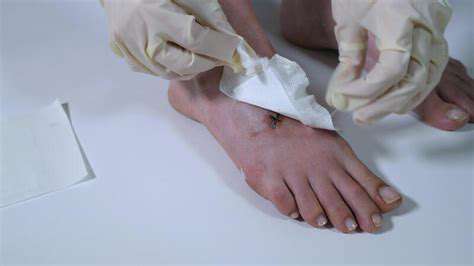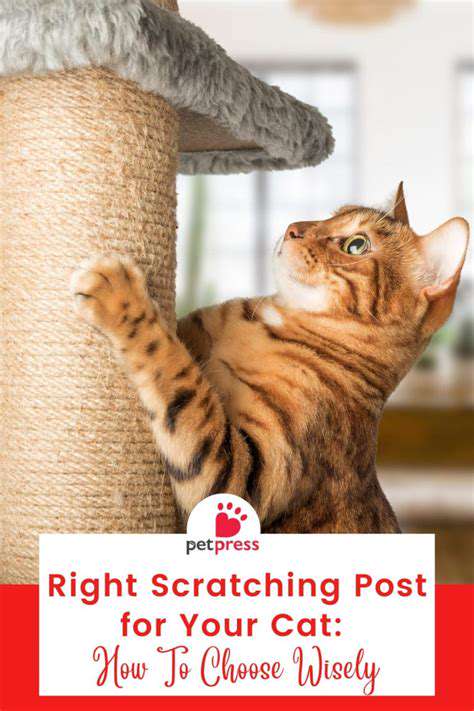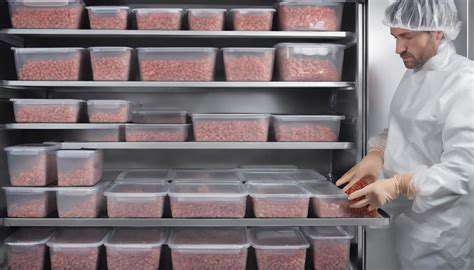Pet First Aid for Cuts and Scrapes: At Home Care
Assessing the Depth of the Wound
A crucial initial step in assessing a pet's wound is determining its depth. A superficial wound, often characterized by minor bleeding and skin irritation, may only require cleaning and gentle care. However, a deep wound, which penetrates deeper layers of skin and potentially underlying tissues, requires immediate veterinary attention. Visual inspection is important, but if the depth is unclear, it's best to err on the side of caution and seek professional help. Determining the depth can be challenging, especially if the wound is located in a difficult-to-reach area or is obscured by fur.
Careful observation and gentle probing can help gauge the depth of the wound. If you can see underlying tissues or bone, this indicates a deeper wound that likely needs veterinary care. Any signs of significant bleeding, swelling, or pain should also prompt immediate veterinary attention.
Identifying the Location of the Wound
Knowing the location of the wound is essential for determining the appropriate course of action. A wound on a paw, for example, might require different treatment than one on the face or torso. Paw wounds are often prone to infection due to constant contact with the ground. Face wounds, on the other hand, can be more complex due to their proximity to sensitive areas and the potential for complications like facial nerve damage. Understanding the precise location will help guide the type of care and potential follow-up necessary.
Evaluating the Extent of Bleeding
Assessing the extent of bleeding is a critical aspect of wound evaluation. Light bleeding, which can be controlled with pressure, might indicate a superficial wound. However, heavy bleeding, a consistent stream of blood, or blood pooling around the wound suggests a more serious injury. Applying direct pressure to the wound is often the first step in controlling bleeding, and if the bleeding is severe or does not stop easily, immediate veterinary attention is necessary.
Recognizing Signs of Infection
signs of infection, such as swelling, redness, pus, or a foul odor around the wound, require immediate veterinary attention. These signs indicate that the wound has become infected, and prompt treatment is crucial to prevent further complications. Early intervention can help prevent the spread of infection and ensure a faster recovery for your pet.
Ignoring these signs can lead to severe health problems, so close observation of the wound is essential. If you notice any of these signs, contact your veterinarian immediately.
Considering the Size of the Wound
The size of the wound is a factor in determining the level of care required. A small, superficial wound may respond well to home care, such as cleaning and bandaging. However, a large wound, especially if deep or bleeding heavily, will likely require veterinary intervention. The size of the wound can be a helpful indicator of the potential severity of the injury. It is important to consider the size of the wound in conjunction with other factors, like depth and bleeding, to determine the best course of action.
Determining the Presence of Foreign Objects
Carefully examine the wound for any foreign objects, such as splinters, glass, or other debris that may be embedded in the tissue. These foreign objects can cause infection and further complications if left untreated. If you suspect a foreign object is present, gently try to remove it, but avoid any forceful attempts that could worsen the injury. If you are unable to remove the object safely, seek immediate veterinary assistance.
Understanding the Pet's Overall Condition
Assessing the pet's overall condition is also important. A healthy, active pet may tolerate a minor wound better than a sick or elderly pet. Consider the pet's overall health when determining the severity of the wound and the necessary course of action. If the pet is showing signs of distress, such as lethargy, vomiting, or difficulty breathing, immediate veterinary attention is crucial. A pet's overall health can significantly impact their ability to heal from a wound.

Applying a Topical Treatment: Choosing the Right Product
Understanding Different Topical Treatments
When dealing with a pet's cut, choosing the right topical treatment is crucial for promoting healing and preventing infection. Different types of topical treatments cater to various needs, from simple scrapes to more serious wounds. Understanding the differences between antiseptic solutions, antibiotic ointments, and wound-healing gels will help you select the most appropriate product for your pet's specific injury.
Antiseptics, for example, primarily work to kill bacteria on the surface of the wound. Antibiotic ointments, on the other hand, contain antibiotics that combat bacterial infections deep within the wound, which is crucial for preventing serious complications. Wound-healing gels often promote tissue regeneration and encourage faster closure of the wound. Consider your pet's specific injury when making your selection.
Assessing the Severity of the Cut
The severity of the cut significantly influences the type of topical treatment required. A minor scrape, for example, might only need a gentle antiseptic wash, while a deeper, more extensive wound may necessitate an antibiotic ointment and potentially even veterinary care. Careful observation of the wound's depth, size, and any signs of infection is essential before applying any topical treatment. Ignoring these factors could lead to complications.
Look for signs of bleeding, swelling, or discharge. If the cut is deep, bleeding heavily, or showing signs of infection, seek immediate veterinary attention. A veterinarian can assess the wound accurately and recommend the most suitable treatment plan.
Selecting the Right Product Based on the Wound Type
Different types of wounds require different treatments. A superficial abrasion might only need a gentle cleanser, while a puncture wound, especially if from a contaminated source, necessitates a more aggressive approach, potentially requiring antibiotics and veterinary care. Consider the potential contaminants and the depth of the wound when choosing the topical treatment.
Understanding the cause of the injury is also important. For example, a cut from a rusty object carries a higher risk of infection, and a more aggressive treatment, possibly involving veterinary consultation, is essential.
Proper Application Techniques for Topical Treatments
Applying topical treatments correctly is just as important as choosing the right product. Ensure the area around the wound is thoroughly cleaned with a gentle, pet-safe cleanser before applying any treatment. Follow the instructions on the product label carefully, paying close attention to dosage and frequency. Excessive use of topical treatments can potentially irritate the skin or interfere with the healing process.
Use clean hands and instruments to apply the treatment, avoiding contact with the surrounding healthy skin. Gently massage the product into the wound, ensuring even distribution. Regular cleaning and reapplication are crucial for effective healing and prevention of infection. If you are unsure about the application technique, consult your veterinarian for guidance.
Considering Potential Allergic Reactions
When introducing any new topical treatment, it's essential to monitor your pet for any signs of allergic reactions. Watch for redness, swelling, itching, or any other unusual behavior. If you notice any adverse reactions, discontinue use immediately and contact your veterinarian for guidance. Introduce new products gradually and carefully observe for any signs of sensitivity or irritation.
Always be aware that pets can react differently to various topical treatments. This is especially true for pets with pre-existing skin conditions or allergies. If you have concerns about potential allergic reactions, consult your veterinarian before using any new topical treatment.
Important Considerations for Prevention
Preventing cuts and injuries in the first place is always the best approach. Keep your pet's environment safe and secure, ensuring there are no hazards that could cause them to injure themselves. Supervise your pet during outdoor activities, and provide appropriate protection against potential hazards. Regular veterinary check-ups can also help identify potential issues early on.
Proper grooming, regular nail trims, and appropriate exercise can contribute significantly to injury prevention. By taking proactive steps to minimize potential risks, you can significantly reduce the chances of your pet sustaining a cut or injury, making topical treatment unnecessary in most cases. Remember that prevention is key.
Managing Pain and Preventing Licking: Strategies for Comfort
Assessing the Wound
A crucial first step in managing a pet's pain and preventing licking is a thorough assessment of the wound. This involves carefully examining the cut for depth, size, and any signs of infection. Look for signs such as redness, swelling, discharge, or excessive bleeding. Knowing the severity of the injury will help determine the appropriate course of action and the level of care needed. It's essential to note the location of the wound as well, as some areas may be more prone to licking and subsequent complications.
Determining if the cut is superficial or deep is vital. Superficial cuts usually heal with minimal intervention. Deep wounds, however, might require veterinary attention. If you have any concerns about the depth or severity, or if the bleeding is excessive, seeking professional veterinary assistance is paramount. A veterinarian can accurately diagnose the wound, recommend appropriate treatment, and prevent potential complications like infection or further injury.
Preventing Licking and Promoting Healing
Licking is a natural instinct for pets, but it can hinder the healing process of a wound. A pet's saliva can introduce bacteria and further irritate the injured area, potentially leading to infection. This is especially important for deep cuts, as the licking can cause additional damage and delay healing. Therefore, preventing licking is a key part of managing pain and ensuring proper wound care.
A variety of methods can help prevent licking. These might include the use of Elizabethan collars, or E-collars, to physically restrict access to the wound. Other options could include soft, comfortable bandages that provide a barrier without causing discomfort. It's important to select a method that prevents licking without causing undue stress or discomfort to the animal. Choosing the right method depends on the pet's temperament, the size and location of the wound, and the potential for the pet to become agitated.
Pain management is also crucial in preventing licking. A pet in pain is more likely to lick its wound. Providing appropriate pain relief can significantly reduce the urge to lick and allow the wound to heal more effectively. Consult with a veterinarian to determine the best pain management strategy for your pet, considering the severity of the injury and the pet's individual needs.
Keeping the pet calm and comfortable is important for both pain management and preventing licking. A quiet, stress-free environment, alongside appropriate pain relief, can significantly reduce the pet's urge to lick the wound and support proper healing.
By implementing these strategies, you can effectively manage your pet's pain and prevent licking, promoting optimal healing and minimizing the risk of complications.
When to Seek Veterinary Care: Recognizing Critical Situations
Recognizing Signs of Severe Bleeding
A significant wound, especially one that's actively bleeding profusely, demands immediate veterinary attention. This is crucial because excessive blood loss can lead to shock and other critical conditions. Look for signs of rapid, heavy bleeding, which might be accompanied by pale gums, weakness, and lethargy. If you suspect severe bleeding, apply direct pressure to the wound, elevate the affected limb if possible, and transport your pet to the nearest veterinary clinic immediately.
Don't attempt to stop the bleeding completely on your own. Your initial priority should be to minimize the blood loss and get your pet to a vet as soon as possible. Proper wound care and treatment are best handled by qualified professionals.
Assessing Difficulty Breathing or Respiratory Distress
If your pet is struggling to breathe, exhibiting rapid or labored breathing, or showing signs of coughing or wheezing, immediate veterinary care is essential. Difficulty breathing can stem from various underlying conditions, including foreign bodies lodged in the airways, allergic reactions, or more serious respiratory infections. Prompt veterinary intervention can be lifesaving in such situations.
Pay close attention to the rate and depth of your pet's breaths. A noticeable change from their normal breathing pattern warrants immediate veterinary evaluation. Do not delay seeking help if you observe these symptoms.
Identifying Severe Pain or Uncontrollable Seizures
Persistent or severe pain, especially if accompanied by whimpering, yelping, or reluctance to move, necessitates immediate veterinary attention. This can be a symptom of a variety of issues, from fractured bones to internal injuries. A pet in significant pain requires pain relief and diagnosis to determine the underlying cause.
Similarly, if your pet experiences seizures that are prolonged, recurring, or accompanied by other symptoms like tremors or loss of consciousness, immediate veterinary care is crucial. Seizures can indicate serious neurological conditions requiring prompt treatment.
Managing Severe Trauma or Injuries
Injuries resulting from accidents, falls, or other traumatic events often require immediate veterinary care. Fractures, lacerations, or other severe wounds may need specialized attention and treatment. If your pet has suffered a traumatic injury, immediately assess the extent of the damage. Immobilize any fractured or dislocated limbs, and ensure the pet is as comfortable and stable as possible before transport to the vet.
Observe the pet for any signs of shock, such as pale gums, weakness, and rapid pulse. Even seemingly minor injuries from falls or accidents should be evaluated by a veterinarian as soon as possible. Preventing further injury and providing appropriate first aid should be considered.
Recognizing Signs of Poisoning or Ingestion of Toxins
If you suspect your pet has ingested a potentially toxic substance, such as household cleaners, medications, or plants, immediate veterinary attention is critical. The signs of poisoning can vary depending on the substance, but they can include vomiting, diarrhea, tremors, difficulty breathing, or unusual behavior. Knowing the substance ingested is key to appropriate treatment, but even without knowing the exact toxin, immediate veterinary evaluation is paramount.
Immediately contact your veterinarian or a veterinary poison control center. Provide them with detailed information about the ingested substance and your pet's symptoms. Prompt treatment can significantly improve the chances of a positive outcome.
Read more about Pet First Aid for Cuts and Scrapes: At Home Care
Hot Recommendations
- Best Pet Bowls: Stainless Steel and Ceramic
- Pet Hydration: Why It's Crucial
- Stop Counter Surfing: Training Your Dog to Stay Off
- Pet Hypothyroidism: Symptoms and Management
- Signs of Pet Liver Disease: What to Watch For
- Pet Emergency Kits: What to Pack
- Dangers of Xylitol: Toxic to Dogs
- Dealing with Pet Diarrhea: When to See a Vet
- Preparing Pets for Travel: Tips for a Smooth Trip
- Pet Depression: Recognizing the Signs











